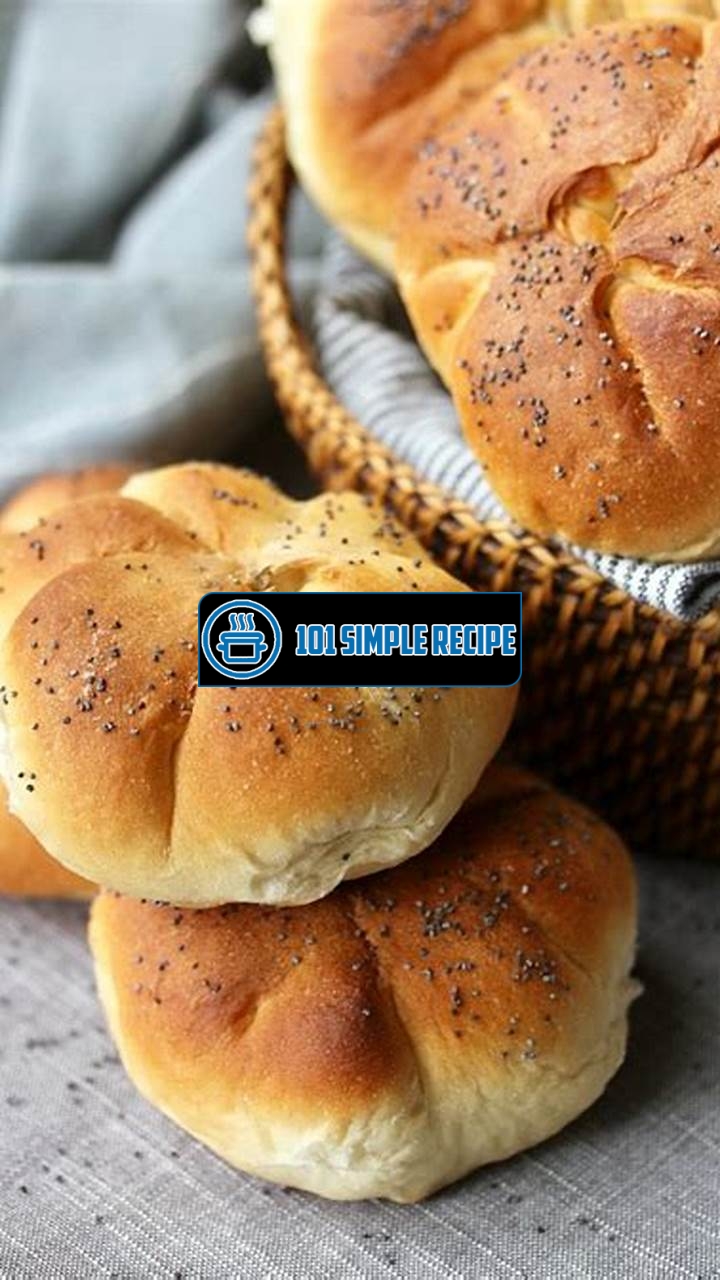Are you craving a delicious and homemade classic? Look no further than this mouthwatering Kaiser Roll recipe. With its golden-brown crust and soft, fluffy interior, these rolls are perfect for sandwiches, burgers, or simply enjoying on their own. Whether you’re a seasoned baker or just starting out, this recipe is sure to impress your family and friends. Get ready to roll up your sleeves and dive into the world of homemade bread with this easy-to-follow recipe. Prepare to fill your kitchen with the irresistible aroma of freshly baked Kaiser Rolls.

The History of Kaiser Rolls
The origins and cultural significance of the popular Kaiser roll can be traced back to Austria, where it first gained prominence. This traditional bread roll has become a beloved classic around the world, known for its distinctive shape and delicious taste.
The Austrian Connection
The Kaiser roll, also known as the Kaisersemmel or Emperor’s roll, originated in Austria during the 18th century. It was named after Emperor Francis Joseph I, who ruled over the Austro-Hungarian Empire from 1848 to 1916. The roll was said to be a favorite of the emperor, which added to its prestige and popularity.
The recipe for Kaiser rolls was initially created by bakers in Vienna, who were known for their mastery of baking techniques. These bakers developed a unique method of shaping the rolls, which resulted in their characteristic appearance. The rolls are typically round with a series of narrows cuts on the top, creating a star-like pattern.
Fun fact: The traditional Kaiser roll was created to celebrate the victory of Austria’s military forces over the Ottoman Turks during the Siege of Vienna in the 17th century.
Symbolism of the Shape
The shape of the Kaiser roll holds symbolic significance. The star-like design on the top represents the crown of the emperor, paying homage to his royal status. The cuts on the top also serve a practical purpose – they allow the dough to expand and rise evenly during baking, resulting in a light and fluffy interior.
Popularity in North America
The popularity of Kaiser rolls transcended borders and made their way to North America during the late 19th and early 20th centuries. As immigrants from various European countries settled in the United States and Canada, they brought their culinary traditions with them, including the beloved Kaiser roll.
Kaiser rolls quickly gained popularity in North America due to their versatility and unique texture. They can be enjoyed as a sandwich roll, a dinner roll, or simply as a snack. Their crisp crust and soft interior make them the perfect vessel for a variety of fillings, from cold cuts and cheeses to spreads and dips.
Did you know? Today, Kaiser rolls are a staple in delis and bakeries across North America, often used for sandwiches like the iconic Reuben or as a side with a hearty bowl of soup.
In conclusion, the history of Kaiser rolls is deeply rooted in Austria’s rich culinary heritage. These delicious bread rolls have become a timeless classic, celebrated for their unique shape, symbolism, and versatility. Whether you’re enjoying a Kaiser roll in Vienna or devouring one in a deli in North America, you can savor the cultural significance and flavor of this homemade classic.
Baking the Perfect Kaiser Roll
When it comes to baking a fluffy and flavorful Kaiser roll, there are a few secrets that can make all the difference. From choosing the right ingredients to mastering the shaping techniques, here are some key tips to help you achieve bakery-quality results in the comfort of your own kitchen.
Choosing the Right Ingredients
The first step in baking the perfect Kaiser roll is selecting high-quality ingredients. Using fresh and organic ingredients can enhance the flavor and texture of your rolls. For this recipe, you’ll need flour, yeast, salt, sugar, butter, and water.
Note: Using high-quality ingredients will make a noticeable difference in the overall taste and texture of your Kaiser rolls.
It’s important to measure your ingredients accurately to ensure the best results. Using a kitchen scale can help you achieve precise measurements, especially when it comes to flour and water.
Note: Accurate measurements are crucial for the proper development of the dough.
Understanding the Dough
Next, let’s dive into the dough. Understanding the characteristics of the dough and how it should feel will help you achieve that light and airy texture in your Kaiser rolls.
The key is to knead the dough until it is smooth and elastic. This process helps to activate the gluten, which gives the rolls their structure. The dough should be slightly tacky to the touch, but not overly sticky. If it is too sticky, you can gradually add more flour.
Note: Proper kneading and consistent texture are vital for the ideal Kaiser roll.
To test if the dough has been kneaded enough, perform the “windowpane test.” Take a small piece of dough and gently stretch it between your fingers. If it forms a thin, translucent membrane without tearing, then it’s ready for the next step.
Shaping Techniques
Now that you have the perfect dough, it’s time to shape your Kaiser rolls. This step is what gives them their iconic twisted appearance.
- Divide the dough into equal portions and roll each piece into a ball.
- Take one ball of dough and flatten it with your palm. Using your fingertips, push into the center of the dough, creating a hole.
- With both thumbs, gently stretch the dough from the center to create a larger hole, while simultaneously rotating it.
- Repeat this process for each ball of dough.
Note: The shaping technique is crucial for achieving the classic Kaiser roll look.
Once you have shaped all the rolls, transfer them to a baking sheet lined with parchment paper. Cover them with a clean kitchen towel and let them rise until they have doubled in size.
Preheat your oven to the recommended temperature, and when the rolls are ready, brush them with an egg wash for a shiny and golden crust.
By following these tips and techniques, you’ll be well on your way to baking delicious and picture-perfect Kaiser rolls from scratch. Enjoy them fresh out of the oven with your favorite spreads or fillings!
The Kaiser Roll Toppings
When it comes to enjoying a Kaiser roll, the right toppings and fillings can take it from ordinary to extraordinary. Exploring various options can help enhance the taste profile and create a memorable eating experience.
Classic Sesame Seed Topping
The classic sesame seed topping is a time-honored choice that adds a delightful crunch to your Kaiser roll. These tiny seeds not only provide a visual appeal but also bring a unique nutty flavor to each bite. Sprinkling sesame seeds on top of the dough before baking creates a beautiful golden crust and elevates the overall taste of the roll. So next time you’re making Kaiser rolls, don’t forget to add this iconic topping for an authentic touch.
Creative Gourmet Fillings
If you’re feeling adventurous and want to take your Kaiser roll to the next level, consider exploring creative gourmet fillings. The possibilities are endless! From savory options like seasoned ground meat, smoked salmon, or roasted vegetables to sweet fillings like chocolate hazelnut spread or fruit compote, there’s something for everyone’s taste buds. Get creative and experiment with different combinations to discover your own signature Kaiser roll masterpiece.
To make your gourmet filling even more enticing, try incorporating contrasting textures and flavors. For example, pair creamy goat cheese with tangy sundried tomatoes or add a refreshing crunch with thinly sliced cucumber. The key is to strike the perfect balance, creating a harmonious blend of ingredients that complements the Kaiser roll’s chewy texture and rich taste.
Healthier Alternatives
For those looking to enjoy a Kaiser roll without the guilt, there are plenty of healthier alternatives to explore. Opting for whole wheat or multigrain Kaiser rolls rather than the traditional white variety can add extra fiber and nutrients to your meal. These alternatives provide a heartier texture and a slightly nutty flavor, enhancing the overall taste experience.
In addition to choosing the right type of roll, consider swapping out high-calorie spreads and fillings for lighter options. Replace mayonnaise with Greek yogurt or avocado, or choose lean protein like grilled chicken breast instead of processed deli meats. By making these small changes, you can still enjoy a delicious Kaiser roll while being mindful of your health goals.
Whether you stick with the classic sesame seed topping, explore gourmet fillings, or opt for healthier alternatives, the key is to have fun and experiment with flavors. There is no right or wrong way to top a Kaiser roll, so let your creativity soar. With the perfect combination of toppings and fillings, your homemade Kaiser roll will become a sought-after culinary delight.
Serving Suggestions and Pairings
When it comes to serving and pairing Kaiser rolls, the possibilities are endless. These homemade classics can be enjoyed in various ways, depending on the occasion and flavor preferences. Whether you’re hosting a brunch, making sandwiches, or looking for accompaniments and dips, Kaiser rolls are a versatile choice that will surely satisfy your taste buds.
The Perfect Brunch Combination
For a delightful brunch experience, consider serving Kaiser rolls alongside a variety of fillings and toppings. Create a build-your-own sandwich station, allowing your guests to customize their rolls to their liking. Offer classic brunch ingredients such as scrambled eggs, bacon, ham, cheese, sliced tomatoes, and avocado. Additionally, include a selection of spreads like mayonnaise, mustard, and pesto to add extra flavor. Don’t forget to provide fresh greens and chopped herbs for those who prefer a lighter option. The combination of warm Kaiser rolls with a wide array of delicious fillings will surely impress your brunch guests.
Kaiser Rolls for Sandwiches
Kaiser rolls are the perfect choice when it comes to making sandwiches. Their shape and texture make them ideal for holding together a variety of ingredients without getting soggy. To make a mouthwatering sandwich, start with a Kaiser roll and layer it with your favorite deli meats, such as roasted turkey, ham, or roast beef. Add cheese, lettuce, tomatoes, pickles, and any other toppings you desire. Whether you prefer a classic ham and cheese or a loaded club sandwich, the Kaiser roll will provide the perfect base for a satisfying meal on the go.
Accompaniments and Dips
Pair your Kaiser rolls with an assortment of accompaniments and dips to elevate their flavor even further. Prepare a charcuterie board with an assortment of cured meats, cheeses, olives, and pickles. The combination of the rich flavors from the cured meats and the crusty Kaiser rolls will create a delightful taste experience. You can also serve the rolls alongside soups or stews, allowing your guests to enjoy the delicious combination of a warm Kaiser roll dipped into a savory broth. Another option is to serve a variety of dips such as hummus, guacamole, or spinach-artichoke dip. These creamy and flavorful dips will add an extra dimension of taste to your Kaiser rolls.
Now that you have learned how to serve and pair Kaiser rolls for different occasions and flavors, it’s time to explore the diverse possibilities. Whether you’re hosting a brunch, making sandwiches, or serving accompaniments and dips, Kaiser rolls are a versatile and delicious choice that will impress your family and friends. So, unleash your creativity and enjoy the homemade classic that is the Kaiser roll!
Regional Variations of Kaiser Rolls
Explore the diverse interpretations and cultural influences of Kaiser rolls around the world.
Kaisersemmel in Germany
In Germany, the Kaiser roll is known as Kaisersemmel. This classic bread roll is characterized by its iconic crown shape and crisp crust. It is widely popular throughout the country and often served as a staple breakfast item or paired with traditional German dishes.
The Kaisersemmel is made with a combination of flour, yeast, salt, and water. The dough is shaped into individual rolls and then scored with diagonal cuts to create the distinctive crown pattern. The rolls are then baked until golden brown.
German cuisine is known for its hearty flavors, and the Kaisersemmel is no exception. It is commonly enjoyed with slices of cheese, cured meats, or butter and jam. Its versatility makes it a favorite choice for sandwiches, too.
Important note: The Kaisersemmel is not to be confused with the similar-looking Brötchen. While they may appear similar, the Brötchen has a lighter texture and is more commonly found in Northern Germany.
The Polish Obwarzanek
In Poland, the Kaiser roll has its own unique variation called Obwarzanek. This circular-shaped bread is often topped with sesame seeds, poppy seeds, or coarse salt, giving it an extra burst of flavor.
The dough for Obwarzanek is typically made with flour, water, yeast, and a pinch of salt. It undergoes a distinctive boiling process before baking, which gives it a chewy texture and glossy finish. The dough is shaped into rings and then briefly boiled in water flavored with malt or sugar.
Obwarzanek is a popular street food in Poland, particularly in the city of Krakow. It is often sold by street vendors who string the rings onto long sticks, creating an eye-catching display. People enjoy eating Obwarzanek plain or with a variety of toppings, such as cream cheese, ham, or pickles.
Koulouri in Greece
Greece also has its own version of the Kaiser roll known as Koulouri. This round bread is typically covered in sesame seeds, giving it a crunchy texture and nutty flavor.
Koulouri is made from a simple dough consisting of flour, water, yeast, olive oil, and a pinch of salt. The dough is shaped into rings and then coated with a generous amount of sesame seeds. It is baked until golden brown and is often enjoyed fresh from the oven.
Throughout Greece, Koulouri is a popular street food snack that can be found in bakeries and from street vendors. It is commonly eaten for breakfast or as a light snack throughout the day. Koulouri pairs well with Greek yogurt or is often enjoyed on its own.
Important note: In certain regions of Greece, Koulouri may also refer to a bread ring without the sesame coating. This variation is typically softer in texture and is commonly served with savory dishes.
As you can see, the Kaiser roll has many regional variations, each with its own unique characteristics and cultural influences. Whether you’re in Germany, Poland, or Greece, you can enjoy the delicious flavors of this homemade classic, whether it’s called Kaisersemmel, Obwarzanek, or Koulouri.
Thank you for taking the time to read our article on the Kaiser roll recipe. We hope you found the instructions clear and easy to follow. Now you can enjoy making fresh and delicious Kaiser rolls at home. Don’t forget to bookmark our website and come back for more exciting recipes and cooking tips. Happy baking!
Frequently Asked Questions
Here are some common questions about the Kaiser roll recipe:
| No. | Questions | Answers |
|---|---|---|
| 1. | Can I substitute bread flour with all-purpose flour? | Yes, you can substitute bread flour with all-purpose flour, but the texture of the rolls may be slightly different. |
| 2. | Can I freeze the baked Kaiser rolls? | Yes, you can freeze the baked Kaiser rolls. Just make sure to let them cool completely before placing them in an airtight container or freezer bag. |
| 3. | How long can I store the baked Kaiser rolls? | You can store the baked Kaiser rolls in an airtight container at room temperature for up to 2 days. |
| 4. | Can I add seeds or toppings to the Kaiser rolls? | Absolutely! You can brush the Kaiser rolls with beaten egg and sprinkle them with sesame seeds, poppy seeds, or any other toppings before baking. |
| 5. | Can I double the recipe? | Yes, you can double the recipe if you need more rolls. Just make sure to adjust the ingredients and baking time accordingly. |
| 6. | Can I make mini Kaiser rolls? | Yes, you can make mini Kaiser rolls by dividing the dough into smaller portions and shaping them accordingly before baking. |
Closing Thoughts
We hope this Kaiser roll recipe has inspired you to try your hand at baking these traditional and flavorful rolls. Homemade Kaiser rolls are perfect for sandwiches, burgers, or simply as a delicious accompaniment to any meal. Remember, practice makes perfect, so don’t be discouraged if your first attempt isn’t picture-perfect. Keep experimenting and enjoy the process of baking your own bread. Thank you for reading, and we look forward to sharing more tasty recipes with you in the future. Happy baking!
Jump to Recipe
Kaiser Roll Recipe

Learn how to make delicious Kaiser rolls at home with this easy recipe. Perfect for sandwiches or as a side to any meal.
- 4 cups bread flour
- 2 tablespoons sugar
- 2 teaspoons active dry yeast
- 1 1/2 teaspoons salt
- 2 tablespoons unsalted butter (softened)
- In a mixing bowl, combine the bread flour, sugar, yeast, and salt. Add the softened butter and warm water. Mix until the dough comes together. Knead the dough for about 5-7 minutes until it becomes smooth and elastic. Place the dough in a greased bowl, cover with a clean kitchen towel, and let it rise in a warm place for about 1 hour or until doubled in size.
- Punch down the dough and divide it into 12 equal portions. Roll each portion into a ball. Take one ball of dough and flatten it slightly. Use your fingers to create 5 small indentations around the edges, forming a star shape. Repeat with the remaining dough balls. Place the shaped rolls on a baking sheet lined with parchment paper.
- Cover the shaped rolls with a clean kitchen towel and let them rise for another 30-45 minutes or until puffy and slightly increased in size.
- Preheat the oven to 425°F (220°C).
- Bake the rolls in the preheated oven for 15-20 minutes or until golden brown. Remove from the oven and let them cool on a wire rack before serving.






